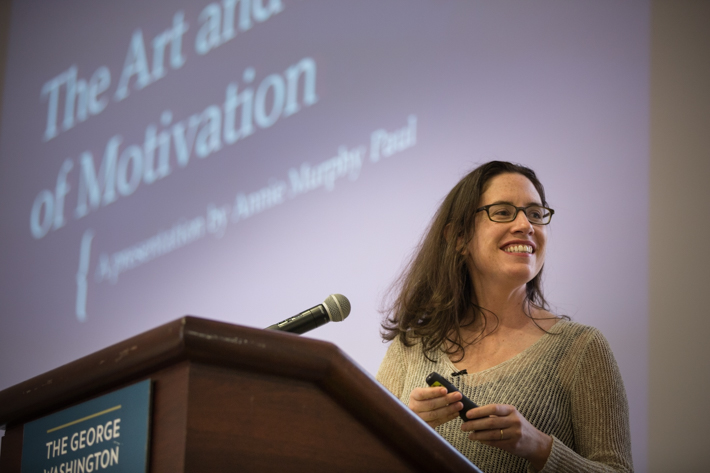By Ruth Steinhardt
In the packed Grand Ballroom of the Marvin Center on Friday, a crowd of noteworthy learners gathered—not a crowd of wide-eyed undergraduates, but seasoned members of the George Washington University faculty.
The occasion was Teaching Day. Sponsored by the GW Teaching and Learning Center, and now in its fourth year, the day’s talk, workshops and resource fair brought teachers from across the disciplines together to discuss critical issues in teaching and learning. It’s one of many resources offered by the UTLC, funded through the provost's office with many initiatives led by faculty to expand course design and teaching support to all GW faculty members.
“We use Teaching Day not only as a resource for our own faculty to learn new and exciting things from outside speakers, but also to show the value that the university places on teaching,” said Dianne Martin, vice provost for faculty affairs. “We have incredible teachers here, and this is a great opportunity for colleagues to learn from one another.”
GW Provost Steven Lerman, opening the event, stressed his philosophy that teaching should be recognized alongside research as key to advancement in academia. Recalling his own time as a young faculty member at the Massachusetts Institute of Technology, he remembered asking the provost, “What is the university doing to make sure we value improving our quality of teaching?”
Now, he said, as a provost himself, he wants always to have an answer to that question.
Teaching Day is an important part of that answer.
The focus of this year’s Teaching Day keynote was on what motivates students and drives them to succeed. Motivated students, said speaker Annie Murphy Paul, aren’t just easier to have in class. They learn more, test better, are more likely to stay in school, graduate on time and ultimately are more successful after graduation.
Ms. Paul, a contributing writer for Time magazine and contributor to numerous other publications including The New York Times Magazine and Slate, suggested that traditional ways of thinking about “motivated” students are flawed.
“We may assume that motivation is innate and unchangeable—that students either have that fire in their belly, or they don’t,” she said.
But that, she said, is misguided. In fact, motivation is “highly malleable,” and research has found methods for fostering deep motivation in all learners.
Ms. Paul set out a simple three-step process for fostering intrinsic motivation in students: dispelling misconceptions, cultivating interest and promoting meaning.
Misconceptions, she said, are powerful among peers, and often come in the form of “pluralistic ignorance”: a majority’s mistaken belief that most others in the group hold a view different from their own. If, for instance, students think that most of their peers don’t prioritize learning, they may act in a way adherent to that perceived norm. Informing them of the reality—that, in fact, the majority of their peers value learning as much as they do—can help correct this.
Interest is a “catch-and-hold” mechanism, Ms. Paul continued: both a state of in-the-moment engagement with a subject and an ability to repeatedly engage with that subject over time. Good teachers, she continued, cultivate interest by aiming for “the zone,” posing questions that are new and complex enough to be challenging without being frustratingly opaque.
The curiosity roused by working through such questions creates what Ms. Paul called a “virtuous cycle,” in which “more learning leads to more questions, which leads to more learning.”
The last concept, promoting meaning, is crucial—but can be a trap, Ms. Paul said, since studies show that emphasizing the importance of learning to students’ futures can actually, perhaps unexpectedly, undermine motivation.
Instead, she suggested, students should be allowed to generate their own connections, thus discovering for themselves the relevance of a subject. Asking students to describe the potential relevance of what they’re learning to their own lives—and to the types of people they are—can greatly increase motivation, Ms. Paul said, especially in students with low expectations for their own performance. So can introducing students to the beneficiaries of the work they do.
After her address, Dr. Lerman and Ms. Paul opened the floor to the audience. An engaged set of students, they posed thoughtful questions on the difficulties that confronted them as teachers. These ranged from combating the “stereotype threat”—students who worry they are at risk of confirming negative stereotypes about their own social group—to working with what one professor called GW’s “over-motivated” students, engaged in so many subjects and activities that they have difficulty learning deeply.
The discussions didn’t end there. Participants could then attend a variety of faculty-led sessions, presentations by their peers on a wide range of teaching-related topics, including blended learning, creative testing, curriculum design and virtual teaming.
Many of the presenters belonged to GW’s Academy of Distinguished Teachers, an honor offered to recipients of the university’s teaching awards. This year, the academy will recognize outstanding teaching with a new GW Golden Apple Award.
In addition, the Continental Ballroom held Teaching Day’s first teaching support fair. At booths and tables around the room were representatives from campus groups that directly support teaching and learning—from Gelman Library to the eDesign shop, headed by Vice Provost Paul Berman, where faculty members can learn to design and implement online courses.
Dr. Martin, who heads the division in which the Teaching and Learning Center is located, said the event was characteristic of the importance GW places on its teachers. And while running new faculty orientation sessions, she said, she’d seen firsthand how strong the university’s reputation in that arena is.
“It’s amazing how many talented people come to teach here, not only because of the resources and opportunities offered, but because GW is viewed as a place where good teaching is valued,” she said.
Dr. Lerman agreed. “We honor teaching today, but we honor teaching every day of the year,” he said.


